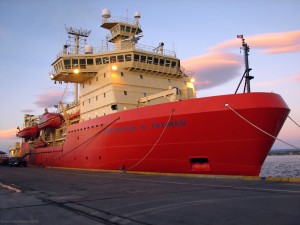ISB in Antarctica
 isbscience.org/news/2013/02/13/isb-in-antarctica-2/
isbscience.org/news/2013/02/13/isb-in-antarctica-2/
There have been many stories in the news about research projects in Antarctica. Most projects are related to the climate and environment, or to how organisms survive in such extreme conditions. On Feb. 6, for example, the New York Times published a report about the Wissard (Whillans Ice Stream Subglacial Access Research Drilling) project, which involves looking for a microbial community in the lake located half a mile under the glacier.
Here’s a link to that story: http://nyti.ms/11FvyyK.

Allison Lee, on the left kicking her foot, is a research associate at ISB. This thermal wear is required on all US Air Force C-130 flights to McMurdo Station in Antarctica.
ISB has a connection to Antarctica, too. Two of our scientists, Mónica Orellana and Allison Lee – both of the Nitin Baliga Group – are participating in the TRACERS (TRacing the fate of Algal Carbon Export in the Ross Sea) project, which is funded by the National Science Foundation’s Antarctic Science Division. Mónica, a senior research scientist and co-PI (prime investigator), will be based in Seattle during the project. But Allison, a research associate, will be on board the RVIB Nathaniel B. Palmer from Feb. 12 to April 5 for the research cruise on the Ross Sea. Scientists from 14 institutions are collaborating to study the carbon cycle of algae. Specifically, the scientists want to understand what happens to the carbon particles as they sink in the Ross Sea.
Why the Ross Sea? The cold water and relative shallowness of the Ross Sea create the ideal environment for the study of algal carbon cycle, because it yields a dense concentration for sampling and a predictable cycle progression. This makes it a model system. In the systems biology approach, a model system can reveal crucial data about the functions and interactions of molecules that potentially can help scientists predict behaviors of molecular and cellular networks in more complex organisms, including humans. At a bigger scale, the Ross Sea is a model to study carbon transformations and export to the deep sea.
As part of ISB’s longtime commitment to science education and transferring knowledge, Mónica, Allison and Baliga Group Education Program Manager, Claudia Ludwig, will adapt this research to implement and extend our inquiry-based high school education module in progress to teach the process of systems biology in context of climate change, carbon cycling and bloom dynamics.
You can keep up with the TRACERS project at this site http://tracers-nbp1302.blogspot.com. Allison will be sharing her experiences from Antarctica via the “Lab Notebook” section of this site.







